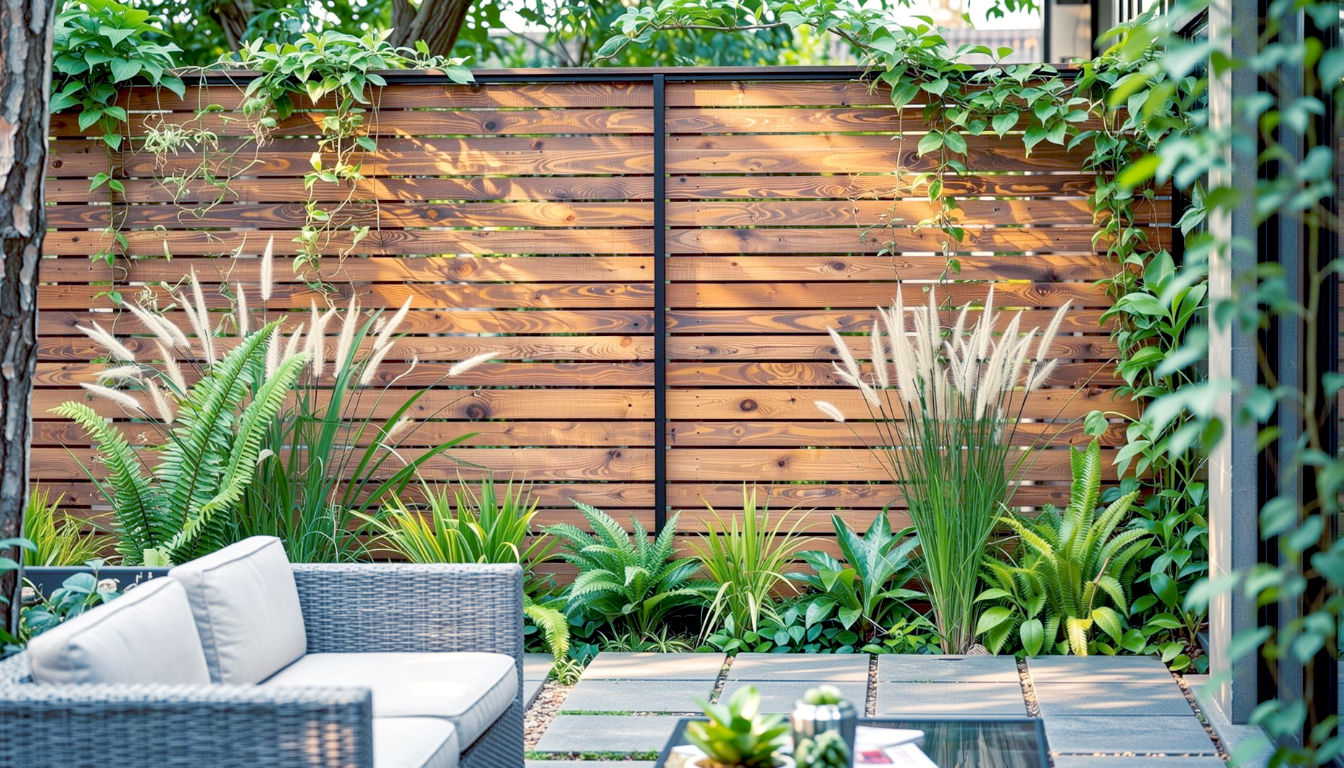The Guide to Horizontal Slatted Fence Panels: A Modern Touch for British Gardens
Thinking of updating your garden with a horizontal slatted fence? Our complete guide covers the best materials for the UK, DIY tips, and modern design ideas.

This post may contain affiliate links. If you make a purchase through these links, we may earn a commission at no additional cost to you.
Ever walk past a house and think, “Wow, their garden looks smart”? Chances are, you might have been admiring a horizontal slatted fence. It’s the sort of clean, crisp garden boundary that’s popping up all over Britain, from trendy city courtyards in Manchester to tidy suburban gardens in the home counties. It’s more than just a fence; it’s a design statement.
For years, the go-to choice for most of us was the classic vertical featherboard or the humble lap panel. They did the job, keeping the dog in and providing a bit of privacy from the neighbours. But let’s be honest, they weren’t always the most inspiring things to look at.
Then, along came horizontal slatted fencing – sometimes called Venetian fencing – and suddenly, garden boundaries became cool. With its long, clean lines, it does something rather clever. It tricks the eye, making your garden feel wider and more spacious than it actually is. It’s a bit like wearing horizontal stripes, but for your outdoor space, and thankfully, the effect is far more flattering.
This guide is your complete handbook to understanding, choosing, and installing the perfect slatted fence for your patch of green. We’ll dig into the different types of wood you can get, explore man-made options that promise a life free from maintenance, and give you the lowdown on how to put them up. Whether you’re a keen DIYer ready to get stuck in or you’d rather leave it to the pros, we’ve got you covered.
So, grab a cuppa, and let’s explore how these simple panels can completely transform your garden.
What Exactly Are Horizontal Slatted Fences?
At its heart, a horizontal slatted fence is exactly what it sounds like: a series of wooden or composite boards (slats) arranged horizontally, usually with small gaps in between. These slats are fixed to vertical posts to create a panel. But this simple description doesn’t quite do it justice.
The magic is in the design. Unlike traditional solid panels that can feel like a heavy, dark wall at the edge of your garden, the gaps in a slatted fence let light and air trickle through. This creates a softer, more dynamic boundary. As the sun moves across the sky, it casts shifting patterns of light and shadow through the slats, bringing a sense of movement and life to your garden.
It’s this blend of privacy and openness that makes them so popular. You get enough screening to stop you from feeling like you’re sitting in your neighbour’s living room, but you don’t feel completely boxed in. It’s a friendly kind of privacy, one that feels modern and welcoming.
The Key Features That Make Them Stand Out
- The Illusion of Space: The strong horizontal lines are the design’s secret weapon. They draw the eye along the length of the garden, creating a visual trick that makes the space feel wider and longer. For the millions of us with smaller urban or new-build gardens, this is a game-changer.
- Contemporary Style: Let’s face it, they look incredibly stylish. Their clean, minimalist aesthetic is a perfect match for modern homes and garden designs. They provide a beautiful, textured backdrop for plants, making lush green ferns and colourful flowers really ‘pop’.
- Controlled Privacy: You can often choose the size of the gap between the slats. Want more privacy? Go for a smaller gap. Happy to have a bit more light and a greater sense of openness? A wider gap will do the trick. This customisation is something you just don’t get with standard fence panels.
- Good for Your Plants (and You): That gentle airflow we mentioned isn’t just nice for you on a warm day; it’s great for your garden’s health. It helps to reduce the risk of mildew on plants growing near the fence line and can make a windy garden feel less blustery by filtering the wind rather than blocking it completely. A solid fence can create turbulent vortices on the leeward side, which is often worse for delicate plants than a steady breeze.
Think of it as the difference between a solid brick wall and a stylish venetian blind. Both give you privacy, but one does it with a much lighter, more elegant touch.
Choosing Your Material: The Great Timber vs. Composite Debate
When it comes to picking the material for your slatted fence, you’re mainly looking at two camps: natural wood (timber) and composite. Each has its fans and its critics, and the right choice for you will come down to your budget, how much maintenance you’re prepared to do, and the look you want to achieve.
The Timeless Appeal of Timber
There’s something undeniably beautiful about natural wood. It’s warm, has unique grain patterns, and blends seamlessly into a garden environment. But not all woods are created equal, especially when they have to face the famously damp and unpredictable British weather.
Cedar: The Premium Choice
If you’ve been swooning over a particularly gorgeous slatted fence online, it was probably made of Western Red Cedar.
- Why it’s loved: Cedar is the gold standard for outdoor timber. It’s naturally rich in oils that make it incredibly resistant to rot, decay, and insect attacks. This means you don’t have to treat it, though many people choose to. Its colour is stunning, ranging from rich reddish-browns to pale ambers. Left to its own devices, it will weather over time to a beautiful, silvery grey.
- What to consider: This quality comes at a price. Cedar is one of the most expensive options, and its softness means it can be dented or scratched more easily than hardwoods.
- Best for: Those looking for a top-of-the-line, beautiful fence that will last for decades with minimal fuss. It’s an investment piece.
Larch: The Durable Contender
Siberian Larch is another fantastic choice, offering many of the benefits of cedar but often at a slightly more accessible price point.
- Why it’s loved: Like cedar, larch is a resinous wood that’s naturally durable and resistant to rot. It’s a bit tougher than cedar, so it can handle knocks a little better. It starts as a warm, straw-yellow colour and, like cedar, weathers to a distinguished silver-grey if left untreated.
- What to consider: It can be more prone to splitting than cedar if not installed carefully, so using good quality stainless steel screws and pre-drilling holes is a must.
- Best for: A high-quality, long-lasting fence that offers a great balance of performance and cost.
Pine/Spruce (Pressure-Treated): The Budget-Friendly Workhorse
This is the most common type of timber you’ll find in British garden centres and timber yards. It’s usually a softwood like pine or spruce that has been put through a process called pressure treatment.
- Why it’s loved: The biggest advantage is cost. It’s significantly cheaper than cedar or larch. The pressure treatment forces preservatives deep into the wood, giving it a good level of protection against rot and insects. This is why you’ll see it used for everything from decking joists to fence posts.
- What to consider: It’s not as naturally durable as cedar or larch and will require regular maintenance (staining or painting) every few years to keep it looking good and properly protected. The wood itself is less stable and can be prone to warping, twisting, or splitting over time. The greenish tinge from the treatment isn’t to everyone’s taste, but it fades, and it can be easily stained or painted.
- Best for: DIY projects, larger gardens where cost is a major factor, or if you plan on painting your fence a specific colour anyway.
The Rise of Composite Fencing
Composite materials are the new kids on the block. They are typically made from a mixture of recycled wood fibres and plastic, creating a board that looks a bit like wood but behaves more like plastic.
- Why it’s loved: The number one selling point is low maintenance. Composite fencing doesn’t rot, warp, or splinter. It never needs staining, sealing, or painting. A quick wash down with soapy water once a year is usually all it needs. It’s also incredibly durable and comes in a range of consistent colours, from slate grey to coffee brown.
- What to consider: The initial cost is often higher than treated pine, sometimes even rivalling the premium timbers. While the quality has improved massively, some people feel it lacks the natural charm and unique character of real wood. It can also get quite hot in direct summer sun. Finally, it’s not a natural material, which can be a drawback for those seeking an eco-friendly garden.
- Best for: Anyone who wants a smart, modern fence without the ongoing chore of maintenance. It’s the “fit and forget” option.
| Feature | Cedar / Larch | Pressure-Treated Pine | Composite |
|---|---|---|---|
| Initial Cost | High | Low | Medium-High |
| Maintenance | Very Low (optional oiling) | Medium (regular staining) | Very Low (occasional wash) |
| Lifespan | 20-30+ years | 10-15 years | 25+ years |
| Appearance | Natural, weathers to silver | Can look treated, paints well | Consistent, manufactured look |
| Eco-Friendly | High (natural, biodegradable) | Medium (treatment chemicals) | Low (contains plastic) |
Planning Your Project: Before You Pick Up a Spade
Right, you’ve decided a slatted fence is for you. Before you get carried away ordering panels, there are a few important things to sort out first. A bit of planning now will save a lot of headaches later.
How High Can You Go? Checking the Rules
In the UK, you don’t usually need planning permission for a fence, as long as you stick to the rules. This is what’s known as ‘permitted development’.
- Front Garden: Any fence in your front garden (meaning, forward of the principal front elevation of your house) must be no higher than 1 metre.
- Back Garden: For the rest of your garden, the limit is 2 metres in height.
- Next to a Highway: If your property borders a road or a footpath alongside a road, the limit is 1 metre.
- Listed Buildings and Conservation Areas: If you live in a listed building, a conservation area, or an Area of Outstanding Natural Beauty, these permitted development rights might not apply. You must check with your local council’s planning department before doing any work. A quick phone call or a look on their website could save you from a very expensive mistake.
It’s always a good idea to have a friendly chat with your neighbours too. Let them know what you’re planning. It’s just common courtesy, and it can prevent any misunderstandings about boundary lines or the finished look of the fence.
Measuring Up: How Much Fencing Do You Need?
This sounds simple, but it pays to be accurate.
- Measure the Total Length: Use a long tape measure to find the total length of the boundary you want to fence. It’s often easier to do this in sections.
- Decide on Post Spacing: Fence panels are usually a standard width, most commonly 1.8 metres (which is just under 6 feet). Your posts will need to be spaced to accommodate this. So, a run of 18 metres would need 10 panels and 11 posts.
- Don’t Forget the Posts: When calculating, remember to account for the width of the posts themselves. Standard wooden posts are usually around 100mm (4 inches) square. For a really sleek, modern look, you might consider aluminium posts, which are slimmer.
- The Awkward End Bit: It’s rare that your fence run will be a perfect multiple of 1.8 metres. You will almost certainly have one section at the end that needs a custom-sized panel. This is totally normal. You can either cut a standard panel down to size or, if you’re building the fence from individual slats, simply build that last bay to the exact size you need.
Top Tip: Always order a little bit extra. One or two extra slats can be a lifesaver if you make a mistake when cutting or if a piece gets damaged.
Posts and Fixings: The Unsung Heroes
The most beautiful fence in the world will look terrible if it’s leaning over after the first winter storm. The posts and fixings are the foundation of your fence, so don’t cut corners here.
- Wooden Posts: The most common choice. Make sure they are pressure-treated and rated for ‘in-ground contact’. For a 1.8-metre high fence, you’ll need at least 2.4-metre long posts. The rule of thumb is that one-third of the post should be in the ground.
- Concrete Posts: Extremely durable and won’t rot. They have slots that the panels slide into. While they are very strong, they have a more industrial look that might not suit the sleek style of a slatted screen.
- Aluminium or Steel Posts: These offer a slim, contemporary profile that complements slatted fencing perfectly. They are strong, long-lasting, and often come as part of a complete system with matching rails and caps. A great, though more expensive, option.
- Fixings: Always use exterior-grade, stainless steel screws. Don’t be tempted to use standard indoor screws. They will rust within months, leaving ugly black streaks running down your beautiful new fence, and will eventually fail.
Installation: DIY or Call in the Professionals?
This is the big question. Do you spend a few weekends getting your hands dirty, or do you pay an expert to get it done quickly and professionally?
The DIY Route: A Rewarding Challenge
Installing a slatted fence is a manageable project for a competent DIYer. If you’re comfortable with a drill, a saw, and a spirit level, you can achieve a fantastic result.
There are two main ways to build it yourself:
1. Buying Pre-Made Panels: This is the easier option. The panels arrive ready-made, and your job is to fix the posts in the ground and then attach the panels to them.
- Pros: Much quicker and ensures a consistent, professional-looking finish.
- Cons: Less flexible for awkward spaces or slopes. Can be more expensive than buying the components separately.
2. Building From Scratch with Individual Slats: This method gives you ultimate control over the finished look. You fix the posts, attach vertical battens to the posts, and then screw each horizontal slat in place one by one.
- Pros: Complete flexibility over height, length, and the size of the gap between slats. Often works out cheaper. You can easily handle sloping ground by stepping the slats or running them parallel to the slope.
- Cons: Much more time-consuming. It requires precision – those gaps need to be perfectly even, or it will look wonky. You’ll need spacer blocks to get it right.
A Quick Step-by-Step for the DIYer:
- Clear the Area: Remove any old fencing, vegetation, and obstructions along the fence line.
- Set Out a Line: Run a builder’s string line between two stakes. This is your guide to keeping the fence perfectly straight.
- Dig the Post Holes: Use a post hole digger (you can hire these). For a 1.8m fence, the holes should be about 60cm (2ft) deep and three times the width of the post.
- Set the Posts: Place the first post in its hole. Use a spirit level to make sure it’s perfectly upright (plumb) in both directions. Pour in a post-mix concrete (like Postcrete), add water, and give it a stir. It sets in minutes, so work quickly! Check the level one last time.
- Position the Next Post: Measure out the distance to your next post (e.g., 1.8m plus the width of one post) and repeat the process. Use a long, straight piece of timber and a spirit level to ensure the tops of the posts are level.
- Attach the Panels/Slats: Once the concrete is fully set (check the bag, but it’s best to leave it 24 hours), you can fix your panels or slats. If using panels, use exterior-grade screws through the panel’s side battens into the posts. If building from scratch, fix your vertical support battens first, then start attaching the horizontal slats from the bottom up, using your spacer block for a consistent gap.
- Finishing Touches: Add post caps to protect the tops of your wooden posts from rain and give a neat finish.
Hiring a Professional: The Stress-Free Option
If the thought of digging dozens of holes and mixing concrete fills you with dread, it might be time to call in a professional fencing contractor or a landscaper.
- Pros: They will do the job much faster than you could. The finish will be professional, straight, and level. They have all the right tools and can handle any unexpected problems, like hitting old concrete underground. You get a guarantee for the work.
- Cons: The main drawback is the cost. Labour can add a significant amount to the total price of the project.
- Finding a Good One: Ask for recommendations from friends or on local community social media groups. Look for traders with a good portfolio of previous work (ask to see pictures!) and check their reviews online. Always get at least three written quotes before making a decision.
Keeping Your Fence Looking Fabulous: Maintenance Tips
You’ve invested time and money in your beautiful new fence; the last thing you want is for it to start looking tired and weathered after a couple of years. A little bit of maintenance goes a long way.
For Natural Timber Fences (Cedar, Larch, Pine)
- To Preserve the Natural Colour: If you love the warm tones of fresh cedar or larch and want to keep them, you’ll need to protect the wood from the sun’s UV rays. Apply a UV-protective wood oil or sealant every year or two. Choose a clear one or one with a slight tint that matches your wood.
- To Embrace the Silver-Grey: If you’re happy for your fence to weather naturally to a silvery grey, you don’t have to do anything, especially with durable woods like cedar and larch. However, giving it a clean once a year will keep it looking its best.
- The Annual Clean: Regardless of the finish, it’s a good idea to give your fence a gentle clean each spring. Use a bucket of warm, soapy water and a soft-bristled brush to scrub away any dirt, cobwebs, or green algae. Avoid using a pressure washer on full power, as it can be too aggressive and damage the surface of the wood, especially softwoods.
- For Treated Pine: This type of wood needs the most help. To keep it protected from the elements and prevent it from looking shabby, you’ll need to apply a fresh coat of fence stain, paint, or oil every 2-4 years, depending on the product you use and how exposed your garden is.
For Composite Fences
This is the easy part. Composite fencing is designed to be virtually maintenance-free.
- The Annual Wash: Simply give it a wash down with a hose or a bucket of soapy water to remove any surface dirt and keep the colour looking fresh. That’s it. No painting, no staining, no fuss.
Design Inspiration: Making a Slatted Fence Your Own
A horizontal slatted fence is more than just a boundary; it’s a design feature. It acts as a stunning backdrop that can define the style of your entire garden.
- The Modern Minimalist Garden: Pair a cedar or dark grey composite fence with simple, architectural plants like bamboo, phormiums, or ornamental grasses. Add some sleek, contemporary garden furniture and you have a chic outdoor room.
- The Urban Courtyard: In a small space, a slatted fence is your best friend. Paint it a dark colour like black or anthracite grey. This might sound counterintuitive, but dark colours actually recede, making the boundaries of the space less obvious and creating a sense of depth. The lush green of your plants will look incredibly vibrant against it.
- Lighting is Everything: Slatted fences look amazing when lit up at night. You can install small uplighters at the base of the fence, weaving them between plants. The light will shine up through the slats, creating beautiful patterns of light and shadow and adding a real touch of drama and sophistication to your garden after dark.
- Create Zones: You don’t just have to use them on the boundary. Use shorter panels of slatted screening inside your garden to create different ‘zones’. It’s a great way to screen off the wheelie bins, hide a compost heap, or create a more secluded, private seating area.
- Go Vertical with Planting: A slatted fence is the perfect canvas for climbing plants. A classic clematis or a fragrant jasmine will happily weave its way through the slats. You can also hang planters and containers from the slats to create a living wall effect, perfect for growing herbs or trailing flowers.
The Final Word
Horizontal slatted fencing is more than just a trend. It’s a stylish, versatile, and practical solution that has fundamentally changed the way we think about our garden boundaries. It proves that something functional can also be beautiful.
By choosing the right material for your budget and lifestyle, and by taking a little time to plan the installation properly, you can create a feature that not only gives you privacy but also adds real value and style to your home. It provides a clean, contemporary canvas that lets your plants, furniture, and landscaping shine.
So next time you look out at your tired old fence panels, perhaps it’s time to think horizontally. You might be surprised at what a difference a few simple lines can make.
Further Reading & Resources
For those looking to delve deeper, here are some highly respected UK-based resources:
- Jackons Fencing Knowledge Hub: A well-regarded UK manufacturer with excellent technical guides and articles on all types of fencing.
- Planning Portal – Fences, Gates and Garden Walls: The official UK government access point for planning permission and building regulations guidance. An essential resource for checking the rules.
- Wood Campus – Timber Cladding & Decking: While focused on cladding, this site provides in-depth technical information about different timber species and their suitability for outdoor use in the UK.






